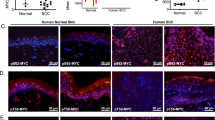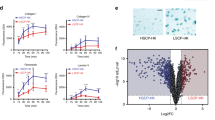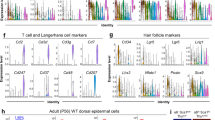Abstract
MYC in human epidermal stem cells can stimulate differentiation rather than uncontrolled proliferation. This discovery was, understandably, greeted with scepticism by researchers. However, subsequent studies have confirmed that MYC can stimulate epidermal stem cells to differentiate and have shed light on the underlying mechanisms. Two concepts that are relevant to cancer have emerged: first, MYC regulates similar genes in different cell types, but the biological consequences are context-dependent; and second, MYC activation is not a simple 'on/off' switch — the cellular response depends on the strength and duration of MYC activity, which in turn is affected by the many cofactors and regulatory pathways with which MYC interacts.
This is a preview of subscription content, access via your institution
Access options
Subscribe to this journal
Receive 12 print issues and online access
$209.00 per year
only $17.42 per issue
Buy this article
- Purchase on Springer Link
- Instant access to full article PDF
Prices may be subject to local taxes which are calculated during checkout






Similar content being viewed by others
References
Fuchs, E. Scratching the surface of skin development. Nature 445, 834–842 (2007).
Owens, D. M. & Watt, F. M. Contribution of stem cells and differentiated cells to epidermal tumours. Nature Rev. Cancer 3, 444–451 (2003).
Watt, F. M., Lo Celso, C. & Silva-Vargas, V. Epidermal stem cells: an update. Curr. Opin. Genet. Dev. 16, 518–524 (2006).
Jones, P. H., Simons, B. D. & Watt, F. M. Sic transit Gloria. Farewell to the epidermal transit amplifying cell? Cell Stem Cell 1, 371–381 (2007).
Boukamp, P. Non-melanoma skin cancer: what drives tumor development and progression? Carcinogenesis 26, 1657–1667 (2005).
Bull, J. J. et al. Contrasting localization of c-Myc with other Myc superfamily transcription factors in the human hair follicle and during the hair growth cycle. J. Invest. Dermatol. 116, 617–622 (2001).
Gandarillas, A. & Watt, F. M. Changes in expression of members of the fos and jun families and myc network during terminal differentiation of human keratinocytes. Oncogene 11, 1403–1407 (1995).
Honma, M., Benitah, S. A. & Watt, F. M. Role of LIM kinases in normal and psoriatic human epidermis. Mol. Biol. Cell 17, 1888–1896 (2006).
Barajon, I. et al. Pattern of expression of c-Myc, Max and Bin1 in human anagen hair follicles. Br. J. Dermatol. 144, 1193–1203 (2001).
Garte, S. J. The c-myc oncogene in tumor progression. Crit. Rev. Oncog. 4, 435–449 (1993).
Littlewood, T. D., Hancock, D. C., Danielian, P. S., Parker, M. G. & Evan, G. I. A modified oestrogen receptor ligand-binding domain as an improved switch for the regulation of heterologous proteins. Nucleic Acids Res. 23, 1686–1690 (1995).
Coffey, R. J. Jr. et al. Selective inhibition of growth-related gene expression in murine keratinocytes by transforming growth factor beta. Mol. Cell. Biol. 8, 3088–3093 (1988).
Jensen, K. B. & Watt, F. M. Single-cell expression profiling of human epidermal stem and transit-amplifying cells: Lrig1 is a regulator of stem cell quiescence. Proc. Natl Acad. Sci. USA 103, 11958–11963 (2006).
Frye, M. & Watt, F. M. The RNA methyltransferase Misu (NSun2) mediates Myc-induced proliferation and is upregulated in tumors. Curr. Biol. 16, 971–981 (2006).
Alexandrow, M. G., Kawabata, M., Aakre, M. & Moses, H. L. Overexpression of the c-Myc oncoprotein blocks the growth-inhibitory response but is required for the mitogenic effects of transforming growth factor β1. Proc. Natl Acad. Sci. USA 92, 3239–3243 (1995).
Hashiro, M., Matsumoto, K., Okumura, H., Hashimoto, K. & Yoshikawa, K. Growth inhibition of human keratinocytes by antisense c-myc oligomer is not coupled to induction of differentiation. Biochem. Biophys. Res. Comm. 174, 287–292 (1991).
Gandarillas, A. & Watt, F. M. c-Myc promotes differentiation of human epidermal stem cells. Genes Dev. 11, 2869–2882 (1997).
Smith, D. P., Bath, M. L., Metcalf, D., Harris, A. W. & Cory, S. Myc levels govern hematopoietic tumor type and latency in transgenic mice. Blood 108, 653–661 (2006).
Gebhardt, A. et al. Myc regulates keratinocyte adhesion and differentiation via complex formation with Miz1. J. Cell Biol. 172, 139–149 (2006).
Gandarillas, A., Goldsmith, L. A., Gschmeissner, S., Leigh, I. M. & Watt, F. M. Evidence that apoptosis and terminal differentiation of epidermal keratinocytes are distinct processes. Exp. Dermatol. 8, 71–79 (1999).
Pelengaris, S., Littlewood, T., Khan, M., Elia, G. & Evan, G. Reversible activation of c-Myc in skin: induction of a complex neoplastic phenotype by a single oncogenic lesion. Mol. Cell 3, 565–577 (1999).
Wanzel, M., Herold, S. & Eilers, M. Transcriptional repression by Myc. Trends Cell Biol. 13, 146–150 (2003).
Knies-Bamforth, U. E., Fox, S. B., Poulsom, R., Evan, G. I. & Harris, A. L. c-Myc interacts with hypoxia to induce angiogenesis in vivo by a vascular endothelial growth factor-dependent mechanism. Cancer Res. 64, 6563–6567 (2004).
Flores, I., Evan, G. & Blasco, M. A. Genetic analysis of myc and telomerase interactions in vivo. Mol. Cell. Biol. 26, 6130–6138 (2006).
Flores, I., Murphy, D. J., Swigart, L. B., Knies, U. & Evan, G. I. Defining the temporal requirements for Myc in the progression and maintenance of skin neoplasia. Oncogene 23, 5923–5930 (2004).
Bull, J. J. et al. Ectopic expression of c-Myc in the skin affects the hair growth cycle and causes an enlargement of the sebaceous gland. Br. J. Dermatol. 152, 1125–1123 (2005).
Waikel, R. L., Wang, X. J. & Roop, D. R. Targeted expression of c-Myc in the epidermis alters normal proliferation, differentiation and UV-B induced apoptosis. Oncogene 18, 4870–4878 (1999).
Arnold, I. & Watt, F. M. c-Myc activation in transgenic mouse epidermis results in mobilization of stem cells and differentiation of their progeny. Curr. Biol. 11, 558–568 (2001).
Waikel, R. L., Kawachi, Y., Waikel, P. A., Wang, X. J. & Roop, D. R. Deregulated expression of c-Myc depletes epidermal stem cells. Nature Genet. 28, 165–168 (2001).
Koster, M. I., Huntzinger, K. A. & Roop, D. R. Epidermal differentiation: transgenic/knockout mouse models reveal genes involved in stem cell fate decisions and commitment to differentiation. J. Investig. Dermatol. Symp. Proc. 7, 41–45 (2002).
Braun, K. M. et al. Manipulation of stem cell proliferation and lineage commitment: visualisation of label-retaining cells in wholemounts of mouse epidermis. Development 130, 5241–5255 (2003).
Frye, M., Gardner, C., Li, E. R., Arnold, I. & Watt, F. M. Evidence that Myc activation depletes the epidermal stem cell compartment by modulating adhesive interactions with the local microenvironment. Development 130, 2793–2780 (2003).
Rounbehler, R. J., Schneider-Broussard, R., Conti, C. J. & Johnson, D. G. Myc lacks E2F1′s ability to suppress skin carcinogenesis. Oncogene 20, 5341–5349 (2001).
Soucek, L., Nasi, S. & Evan, G. I. Omomyc expression in skin prevents Myc-induced papillomatosis. Cell Death Differ. 11, 1038–1045 (2004).
Gebhardt, A. et al. Miz1 is required for hair follicle structure and hair morphogenesis. J. Cell Sci. 120, 2586–2593 (2007).
Wu, S. et al. Myc represses differentiation-induced p21CIP1 expression via Miz-1-dependent interaction with the p21 core promoter. Oncogene 22, 351–360 (2003).
Zanet, J. et al. Endogenous Myc controls mammalian epidermal cell size, hyperproliferation, endoreplication and stem cell amplification. J. Cell Sci. 118, 1693–1704 (2005).
Oskarsson, T. et al. Skin epidermis lacking the c-Myc gene is resistant to Ras-driven tumorigenesis but can reacquire sensitivity upon additional loss of the p21Cip1 gene. Genes Dev. 20, 2024–2029 (2006).
Mill, P. et al. Shh controls epithelial proliferation via independent pathways that converge on N-Myc. Dev. Cell 9, 293–303 (2005).
Silva-Vargas, V. et al. β-catenin and Hedgehog signal strength can specify number and location of hair follicles in adult epidermis without recruitment of bulge stem cells. Dev. Cell 9, 121–131 (2005).
Watt, F. M. Role of integrins in regulating epidermal adhesion, growth and differentiation. EMBO J. 21, 3919–3926 (2002).
Benitah, S. A., Frye, M., Glogauer, M. & Watt, F. M. Stem cell depletion through epidermal deletion of Rac1. Science 309, 933–935 (2005).
Huang, Z., Traugh, J. A. & Bishop, J. M. Negative control of the Myc protein by the stress-responsive kinase Pak2. Mol. Cell. Biol. 24, 1582–1594 (2004).
Benitah, S. A. & Watt, F. M. Epidermal deletion of Rac1 causes stem cell depletion, irrespective of whether deletion occurs during embryogenesis or adulthood. J. Invest. Dermatol. 127, 1555–1557 (2007).
Chrostek, A. et al. Rac1 is crucial for hair follicle integrity but is not essential for maintenance of the epidermis. Mol. Cell. Biol. 26, 6957–6970 (2006).
Castilho, R. M. et al. Requirement of Rac1 distinguishes follicular from interfollicular epithelial stem cells. Oncogene 26, 5078–5085 (2007).
Murphy, M. J., Wilson, A. & Trumpp, A. More than just proliferation: Myc function in stem cells. Trends Cell Biol. 15, 128–137 (2005).
Cowling, V. H. & Cole, M. D. E-cadherin repression contributes to c-Myc-induced epithelial cell transformation. Oncogene 26, 3582–3586 (2007).
Sumi, T., Tsuneyoshi, N., Nakatsuji, N. & Suemori, H. Apoptosis and differentiation of human embryonic stem cells induced by sustained activation of c-Myc. Oncogene 26, 5564–5576 (2007).
Wilson, A. et al. c-Myc controls the balance between hematopoietic stem cell self-renewal and differentiation. Genes Dev. 18, 2747–2763 (2004).
Amati, B., Frank, S. R., Donjerkovic, D. & Taubert, S. Function of the c-Myc oncoprotein in chromatin remodeling and transcription. Biochim. Biophys. Acta 1471, M135–M145 (2001).
Frank, S. R. et al. MYC recruits the TIP60 histone acetyltransferase complex to chromatin. EMBO Rep. 4, 575–580 (2003).
Knoepfler, P. S. et al. Myc influences global chromatin structure. EMBO J. 25, 2723–2734 (2006).
Frye, M., Fisher, A. G. & Watt, F. M. Epidermal stem cells are defined by global histone modifications that are altered by Myc-induced differentiation. PLoS ONE 2, e763 (2007).
Secombe, J., Li, L., Carlos, L. & Eisenman, R. N. The Trithorax group protein Lid is a trimethyl histone H3K4 demethylase required for dMyc-induced cell growth. Genes Dev. 21, 537–551 (2007).
Markova, N. G., Karaman-Jurukovska, N., Pinkas-Sarafova, A., Marekov, L. N. & Simon, M. Inhibition of histone deacetylation promotes abnormal epidermal differentiation and specifically suppresses the expression of the late differentiation marker profilaggrin. J. Invest. Dermatol. 127, 1126–1139 (2007).
Takahashi, K. & Yamanaka, S. Induction of pluripotent stem cells from mouse embryonic and adult fibroblast cultures by defined factors. Cell 126, 663–676 (2006).
Wernig, M. et al. In vitro reprogramming of fibroblasts into a pluripotent ES-cell-like state. Nature 448, 318–324 (2007).
Nakagawa, M. et al. Generation of induced pluripotent stem cells without Myc from mouse and human fibroblasts. Nature Biotechnol. (in the press).
Dai, X., Schonbaum, C., Degenstein, L., Bai, W., Mahowald, A. & Fuchs, E. The ovo gene required for cuticle formation and oogenesis in flies is involved in hair formation and spermatogenesis in mice. Genes Dev. 12, 3452–3463 (1998).
Nair, M. et al. Ovol1 regulates the growth arrest of embryonic epidermal progenitor cells and represses c-myc transcription. J. Cell Biol. 173, 253–264 (2006).
Gomis, R. R. et al. FoxO-Smad synexpression group in human keratinocytes. Proc. Natl Acad. Sci. USA 103, 12747–12752 (2006).
Kallies, A. & Nutt, S. L. Terminal differentiation of lymphocytes depends on Blimp-1. Curr. Opin. Immunol. 19, 156–162 (2007).
Horsley, V. et al. Blimp1 defines a progenitor population that governs cellular input to the sebaceous gland. Cell 126, 597–609 (2006).
Magnúsdóttir, E. et al. Epidermal terminal differentiation depends on B lymphocyte-induced maturation protein-1. Proc. Natl Acad. Sci. USA 104, 14988–14993 (2007).
van de Wetering, M. et al. The β-catenin/TCF-4 complex imposes a crypt progenitor phenotype on colorectal cancer cells. Cell 111, 241–250 (2002).
Niemann, C., Owens, D. M., Hülsken, J., Birchmeier, W. & Watt, F. M. Expression of ΔNLef1 in mouse epidermis results in differentiation of hair follicles into squamous epidermal cysts and formation of skin tumours. Development 129, 95–109 (2002).
Niemann, C., Owens, D. M., Schettina, P. & Watt, F. M. Dual role of inactivating Lef1 mutations in epidermis: tumor promotion and specification of tumor type. Cancer Res. 67, 2916–2921 (2007).
Williamson, L. et al. Pemphigus vulgaris identifies plakoglobin as key suppressor of c-Myc in the skin. EMBO J. 25, 3298–3309 (2006).
Gallant P. Control of transcription by Pontin and Reptin. Trends Cell Biol. 17, 187–192 (2007).
Etard, C., Gradl, D., Kunz, M. & Wedlich, D. Pontin and Reptin regulate cell proliferation in early Xenopus embryos in collaboration with c-Myc and Miz-1. Mech. Dev. 122, 545–556 (2005).
Senoo-Matsuda, N. & Johnston, L. A. Soluble factors mediate competitive and cooperative interactions between cells expressing different levels of Drosophila Myc. Proc. Natl Acad. Sci. USA 104, 18543–18548 (2007).
Evans, R. D. et al. A tumor-associated β1 integrin mutation that abrogates epithelial differentiation control. J. Cell Biol. 160, 589–596 (2003).
Zahir, N. et al. Autocrine laminin-5 ligates α6β4 integrin and activates RAC and NFκB to mediate anchorage-independent survival of mammary tumors. J. Cell Biol. 163, 1397–1407 (2003).
Brenner, C. et al. Myc represses transcription through recruitment of DNA methyltransferase corepressor. EMBO J. 24, 336–346 (2005).
Satou, A., Taira, T., Iguchi-Ariga, S. M. & Ariga, H. A novel transrepression pathway of c-Myc. Recruitment of a transcriptional corepressor complex to c-Myc by MM-1, a c-Myc-binding protein. J. Biol. Chem. 276, 46562–46567 (2001).
Author information
Authors and Affiliations
Corresponding author
Related links
Related links
DATABASES
National cancer Institute
FURTHER INFORMATION
Rights and permissions
About this article
Cite this article
Watt, F., Frye, M. & Benitah, S. MYC in mammalian epidermis: how can an oncogene stimulate differentiation?. Nat Rev Cancer 8, 234–242 (2008). https://doi.org/10.1038/nrc2328
Issue Date:
DOI: https://doi.org/10.1038/nrc2328
This article is cited by
-
VAV2 orchestrates the interplay between regenerative proliferation and ribogenesis in both keratinocytes and oral squamous cell carcinoma
Scientific Reports (2024)
-
Myc-dependent dedifferentiation of Gata6+ epidermal cells resembles reversal of terminal differentiation
Nature Cell Biology (2023)
-
Connectome and regulatory hubs of CAGE highly active enhancers
Scientific Reports (2023)
-
Protooncogene MYC drives human melanocyte melanogenesis and senescence
Cancer Gene Therapy (2022)
-
Basal Cells in the Epidermis and Epidermal Differentiation
Stem Cell Reviews and Reports (2022)



